Tax Law Assignment - Income Tax: Ordinary, Statutory Income Analysis
VerifiedAdded on 2022/09/12
|6
|801
|18
Homework Assignment
AI Summary
This document presents solutions to a tax law assignment, addressing key concepts of income taxation. The assignment explores the distinction between ordinary and statutory income, providing definitions and examples. It analyzes specific scenarios, such as tips received by a waiter, payments from employers, and receipts from various sources, including welfare and scholarships. The solutions cite relevant sections of the ITAA 1997 and case law, such as "Calvert v Wainwright," "Westfield v FCT," and "FCT v DP Smith," to support the analysis. Additionally, the assignment covers the tax treatment of payments received for relinquishing rights and the implications of annuities and prizes. The document offers a comprehensive understanding of income assessment and its practical applications.
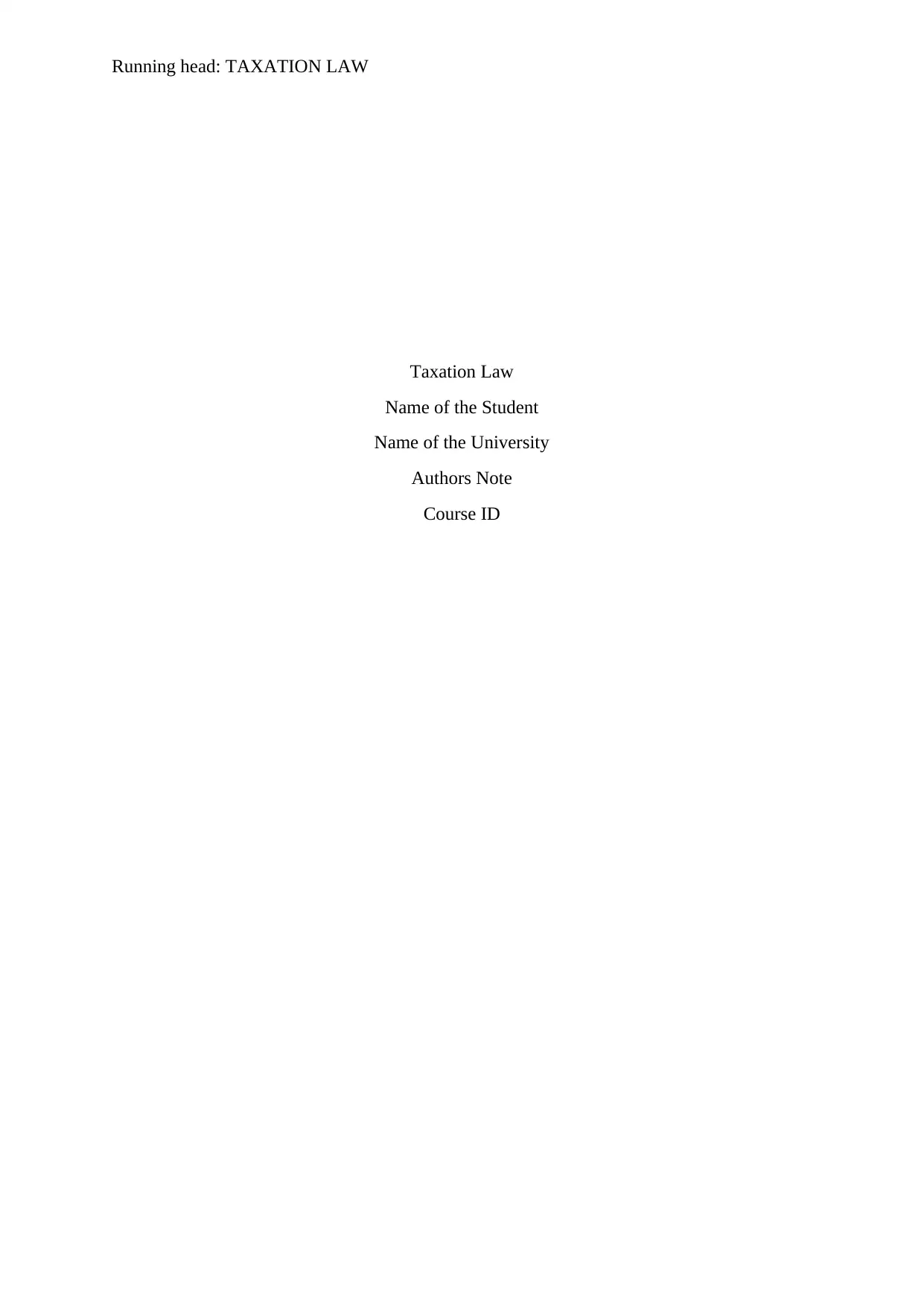
Running head: TAXATION LAW
Taxation Law
Name of the Student
Name of the University
Authors Note
Course ID
Taxation Law
Name of the Student
Name of the University
Authors Note
Course ID
Paraphrase This Document
Need a fresh take? Get an instant paraphrase of this document with our AI Paraphraser
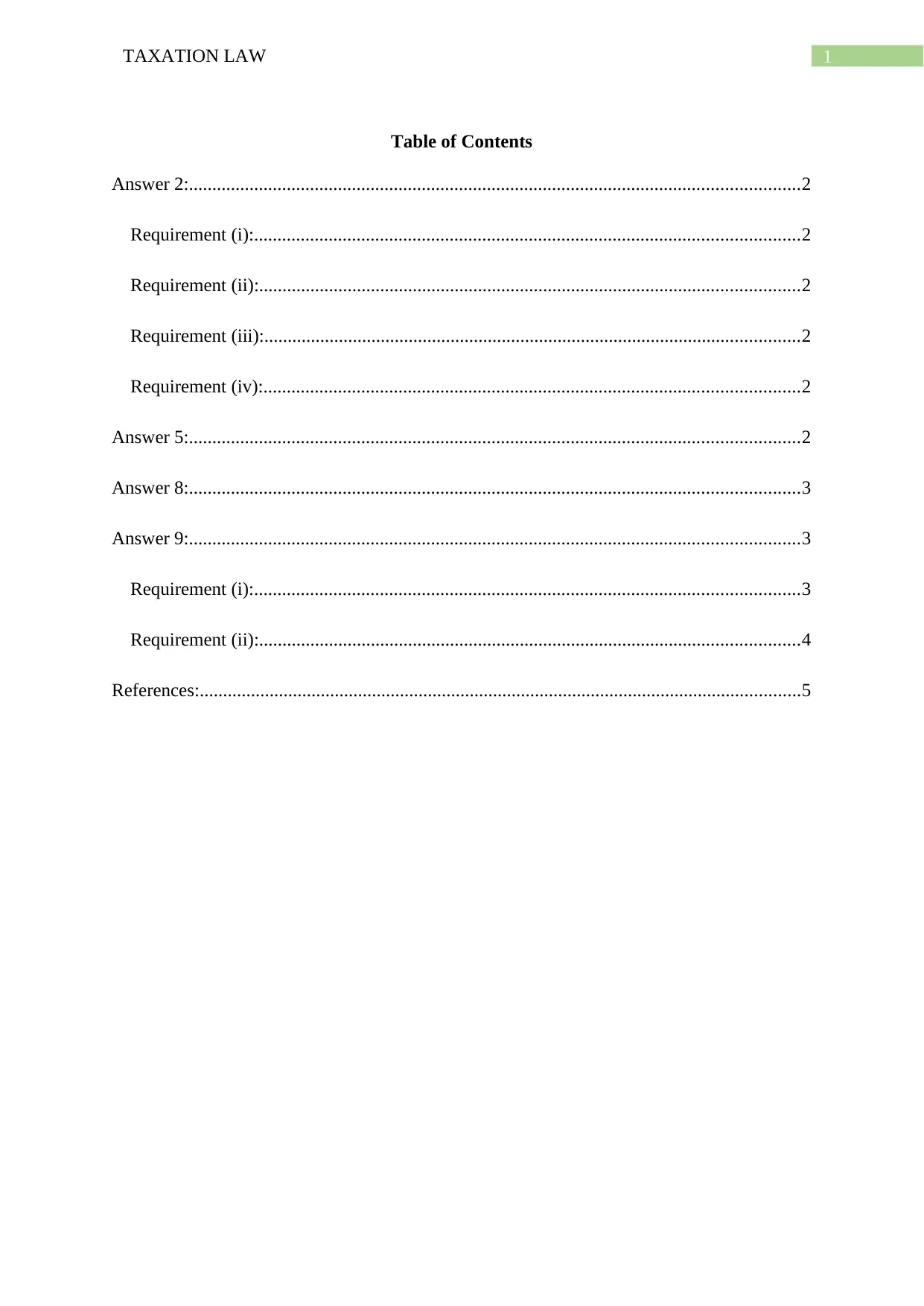
1TAXATION LAW
Table of Contents
Answer 2:...................................................................................................................................2
Requirement (i):.....................................................................................................................2
Requirement (ii):....................................................................................................................2
Requirement (iii):...................................................................................................................2
Requirement (iv):...................................................................................................................2
Answer 5:...................................................................................................................................2
Answer 8:...................................................................................................................................3
Answer 9:...................................................................................................................................3
Requirement (i):.....................................................................................................................3
Requirement (ii):....................................................................................................................4
References:.................................................................................................................................5
Table of Contents
Answer 2:...................................................................................................................................2
Requirement (i):.....................................................................................................................2
Requirement (ii):....................................................................................................................2
Requirement (iii):...................................................................................................................2
Requirement (iv):...................................................................................................................2
Answer 5:...................................................................................................................................2
Answer 8:...................................................................................................................................3
Answer 9:...................................................................................................................................3
Requirement (i):.....................................................................................................................3
Requirement (ii):....................................................................................................................4
References:.................................................................................................................................5
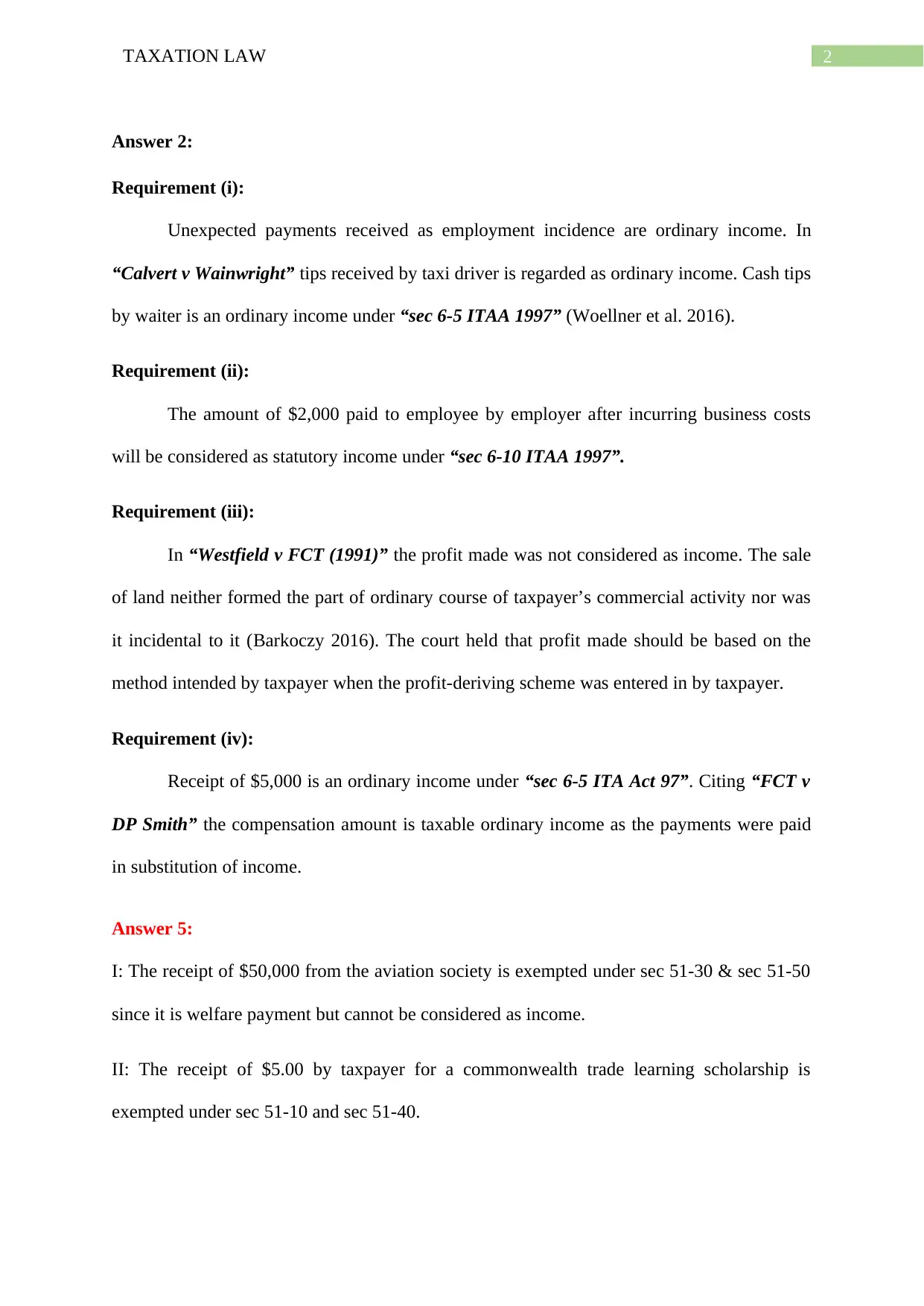
2TAXATION LAW
Answer 2:
Requirement (i):
Unexpected payments received as employment incidence are ordinary income. In
“Calvert v Wainwright” tips received by taxi driver is regarded as ordinary income. Cash tips
by waiter is an ordinary income under “sec 6-5 ITAA 1997” (Woellner et al. 2016).
Requirement (ii):
The amount of $2,000 paid to employee by employer after incurring business costs
will be considered as statutory income under “sec 6-10 ITAA 1997”.
Requirement (iii):
In “Westfield v FCT (1991)” the profit made was not considered as income. The sale
of land neither formed the part of ordinary course of taxpayer’s commercial activity nor was
it incidental to it (Barkoczy 2016). The court held that profit made should be based on the
method intended by taxpayer when the profit-deriving scheme was entered in by taxpayer.
Requirement (iv):
Receipt of $5,000 is an ordinary income under “sec 6-5 ITA Act 97”. Citing “FCT v
DP Smith” the compensation amount is taxable ordinary income as the payments were paid
in substitution of income.
Answer 5:
I: The receipt of $50,000 from the aviation society is exempted under sec 51-30 & sec 51-50
since it is welfare payment but cannot be considered as income.
II: The receipt of $5.00 by taxpayer for a commonwealth trade learning scholarship is
exempted under sec 51-10 and sec 51-40.
Answer 2:
Requirement (i):
Unexpected payments received as employment incidence are ordinary income. In
“Calvert v Wainwright” tips received by taxi driver is regarded as ordinary income. Cash tips
by waiter is an ordinary income under “sec 6-5 ITAA 1997” (Woellner et al. 2016).
Requirement (ii):
The amount of $2,000 paid to employee by employer after incurring business costs
will be considered as statutory income under “sec 6-10 ITAA 1997”.
Requirement (iii):
In “Westfield v FCT (1991)” the profit made was not considered as income. The sale
of land neither formed the part of ordinary course of taxpayer’s commercial activity nor was
it incidental to it (Barkoczy 2016). The court held that profit made should be based on the
method intended by taxpayer when the profit-deriving scheme was entered in by taxpayer.
Requirement (iv):
Receipt of $5,000 is an ordinary income under “sec 6-5 ITA Act 97”. Citing “FCT v
DP Smith” the compensation amount is taxable ordinary income as the payments were paid
in substitution of income.
Answer 5:
I: The receipt of $50,000 from the aviation society is exempted under sec 51-30 & sec 51-50
since it is welfare payment but cannot be considered as income.
II: The receipt of $5.00 by taxpayer for a commonwealth trade learning scholarship is
exempted under sec 51-10 and sec 51-40.
⊘ This is a preview!⊘
Do you want full access?
Subscribe today to unlock all pages.

Trusted by 1+ million students worldwide
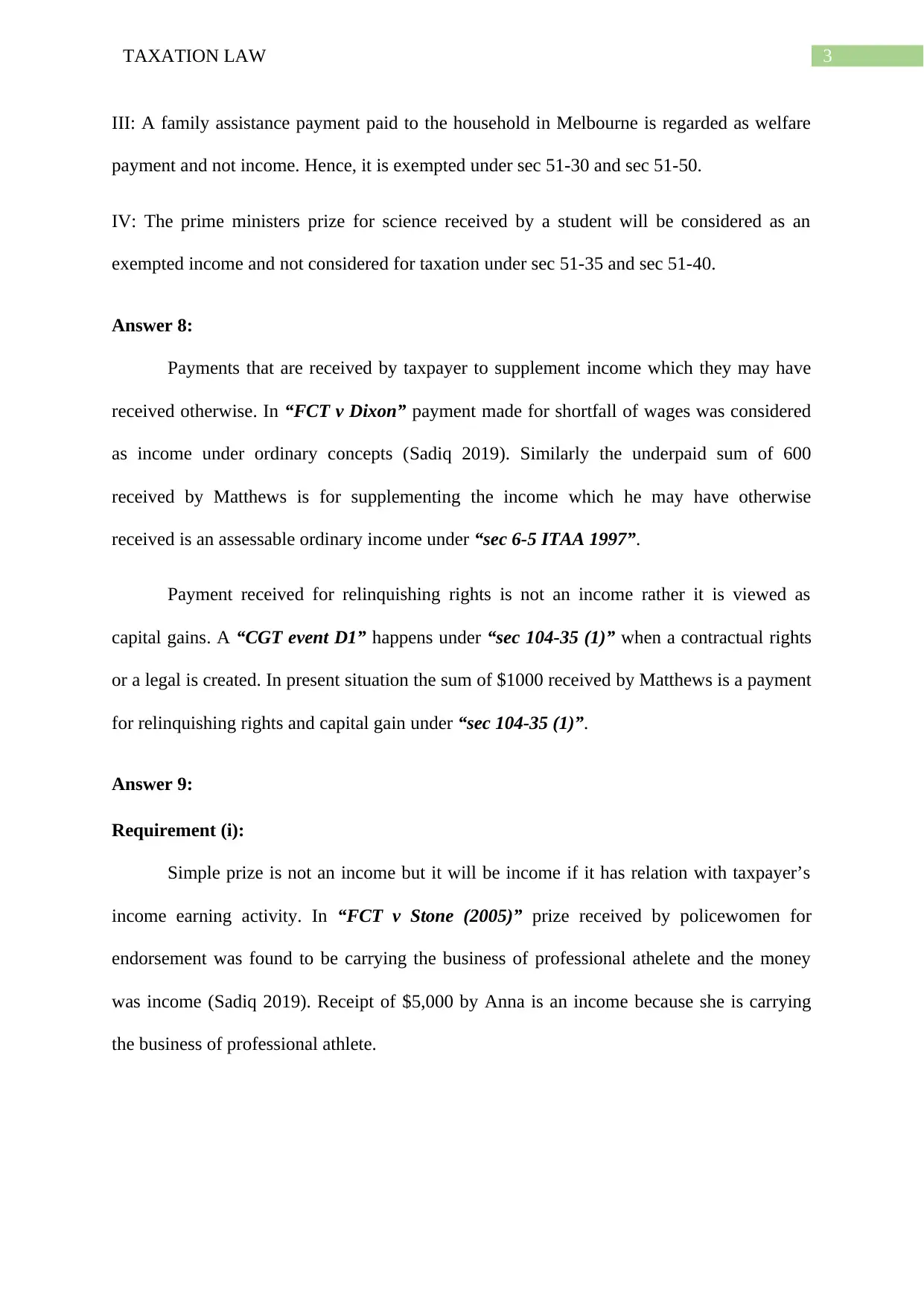
3TAXATION LAW
III: A family assistance payment paid to the household in Melbourne is regarded as welfare
payment and not income. Hence, it is exempted under sec 51-30 and sec 51-50.
IV: The prime ministers prize for science received by a student will be considered as an
exempted income and not considered for taxation under sec 51-35 and sec 51-40.
Answer 8:
Payments that are received by taxpayer to supplement income which they may have
received otherwise. In “FCT v Dixon” payment made for shortfall of wages was considered
as income under ordinary concepts (Sadiq 2019). Similarly the underpaid sum of 600
received by Matthews is for supplementing the income which he may have otherwise
received is an assessable ordinary income under “sec 6-5 ITAA 1997”.
Payment received for relinquishing rights is not an income rather it is viewed as
capital gains. A “CGT event D1” happens under “sec 104-35 (1)” when a contractual rights
or a legal is created. In present situation the sum of $1000 received by Matthews is a payment
for relinquishing rights and capital gain under “sec 104-35 (1)”.
Answer 9:
Requirement (i):
Simple prize is not an income but it will be income if it has relation with taxpayer’s
income earning activity. In “FCT v Stone (2005)” prize received by policewomen for
endorsement was found to be carrying the business of professional athelete and the money
was income (Sadiq 2019). Receipt of $5,000 by Anna is an income because she is carrying
the business of professional athlete.
III: A family assistance payment paid to the household in Melbourne is regarded as welfare
payment and not income. Hence, it is exempted under sec 51-30 and sec 51-50.
IV: The prime ministers prize for science received by a student will be considered as an
exempted income and not considered for taxation under sec 51-35 and sec 51-40.
Answer 8:
Payments that are received by taxpayer to supplement income which they may have
received otherwise. In “FCT v Dixon” payment made for shortfall of wages was considered
as income under ordinary concepts (Sadiq 2019). Similarly the underpaid sum of 600
received by Matthews is for supplementing the income which he may have otherwise
received is an assessable ordinary income under “sec 6-5 ITAA 1997”.
Payment received for relinquishing rights is not an income rather it is viewed as
capital gains. A “CGT event D1” happens under “sec 104-35 (1)” when a contractual rights
or a legal is created. In present situation the sum of $1000 received by Matthews is a payment
for relinquishing rights and capital gain under “sec 104-35 (1)”.
Answer 9:
Requirement (i):
Simple prize is not an income but it will be income if it has relation with taxpayer’s
income earning activity. In “FCT v Stone (2005)” prize received by policewomen for
endorsement was found to be carrying the business of professional athelete and the money
was income (Sadiq 2019). Receipt of $5,000 by Anna is an income because she is carrying
the business of professional athlete.
Paraphrase This Document
Need a fresh take? Get an instant paraphrase of this document with our AI Paraphraser
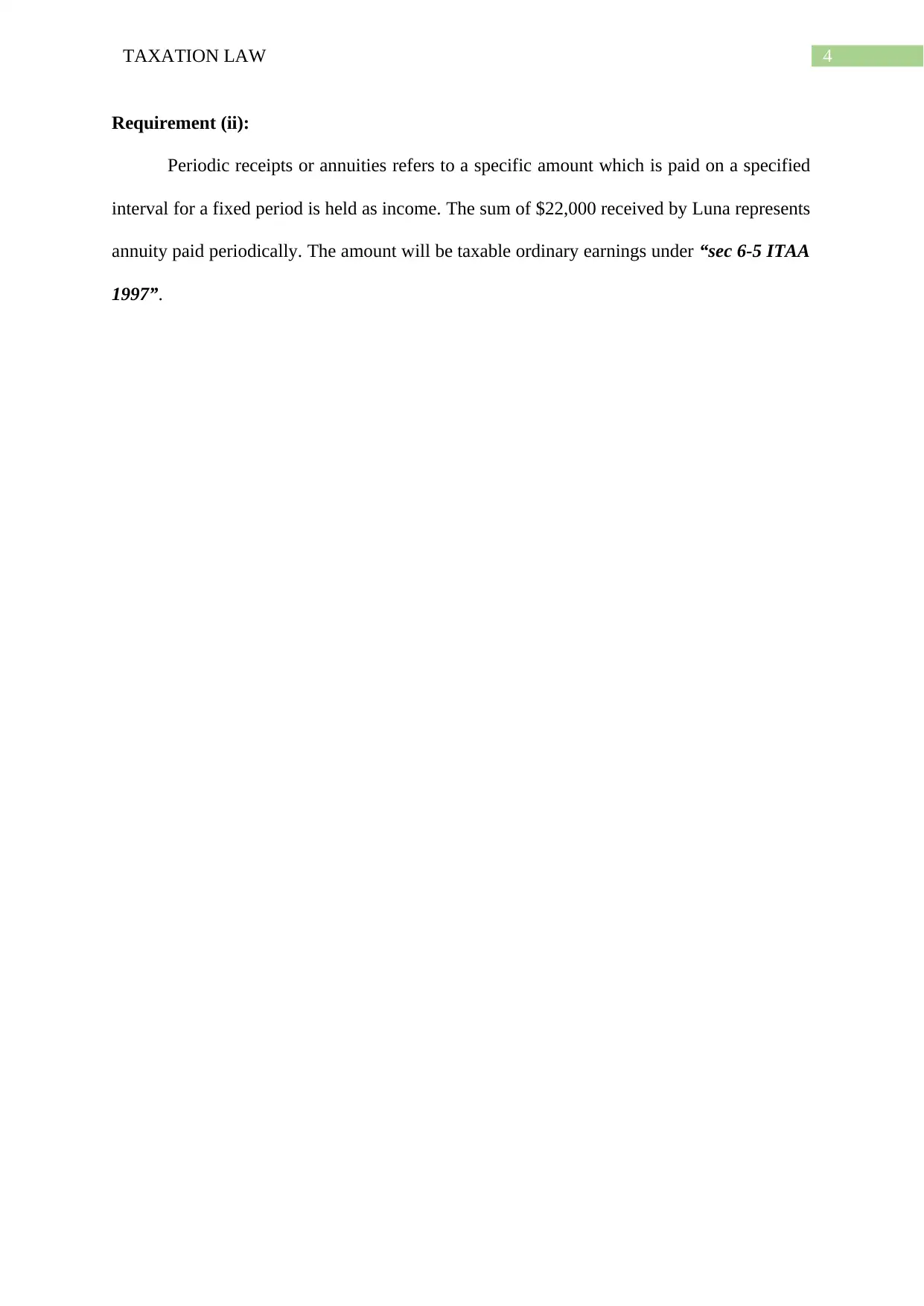
4TAXATION LAW
Requirement (ii):
Periodic receipts or annuities refers to a specific amount which is paid on a specified
interval for a fixed period is held as income. The sum of $22,000 received by Luna represents
annuity paid periodically. The amount will be taxable ordinary earnings under “sec 6-5 ITAA
1997”.
Requirement (ii):
Periodic receipts or annuities refers to a specific amount which is paid on a specified
interval for a fixed period is held as income. The sum of $22,000 received by Luna represents
annuity paid periodically. The amount will be taxable ordinary earnings under “sec 6-5 ITAA
1997”.
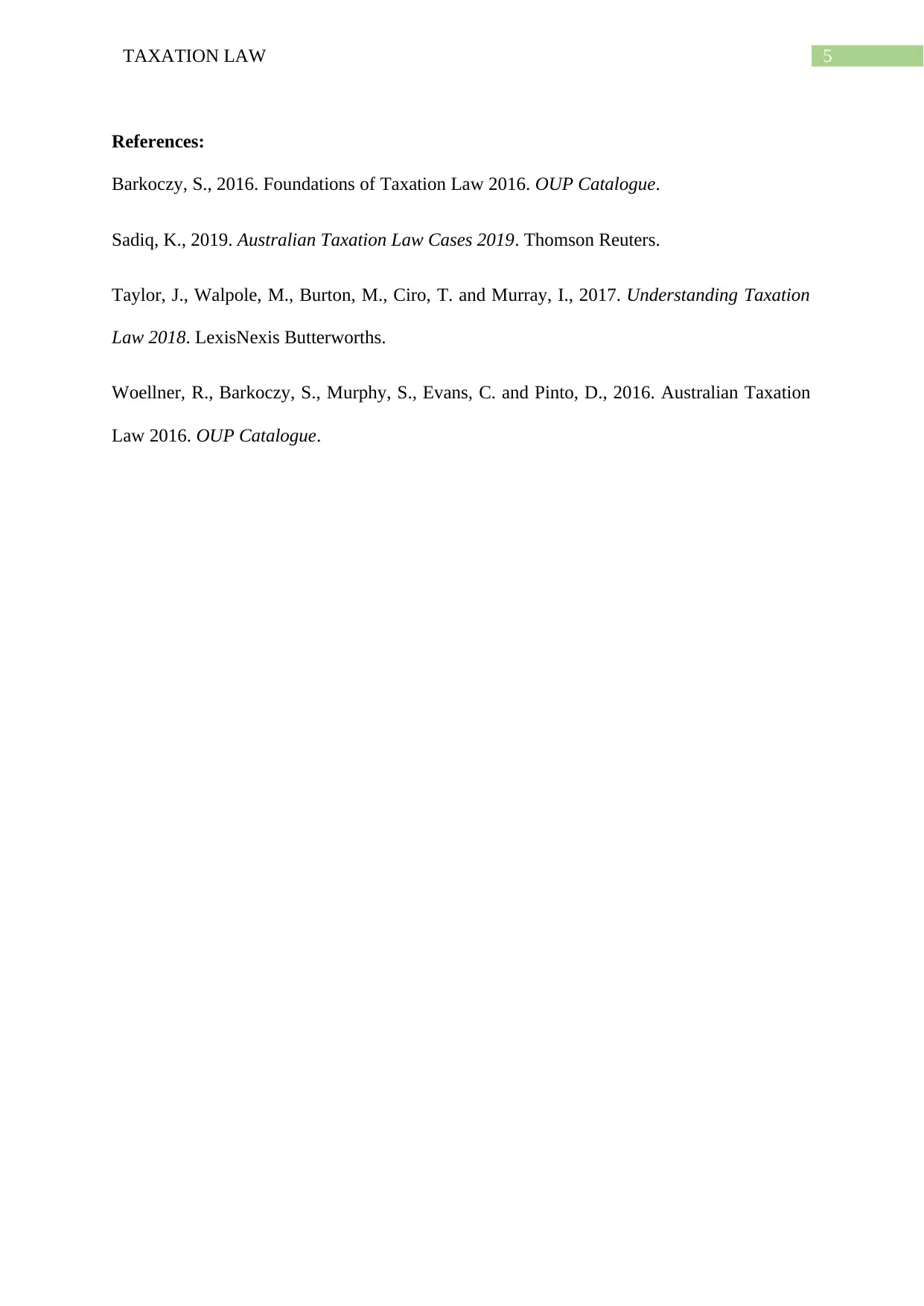
5TAXATION LAW
References:
Barkoczy, S., 2016. Foundations of Taxation Law 2016. OUP Catalogue.
Sadiq, K., 2019. Australian Taxation Law Cases 2019. Thomson Reuters.
Taylor, J., Walpole, M., Burton, M., Ciro, T. and Murray, I., 2017. Understanding Taxation
Law 2018. LexisNexis Butterworths.
Woellner, R., Barkoczy, S., Murphy, S., Evans, C. and Pinto, D., 2016. Australian Taxation
Law 2016. OUP Catalogue.
References:
Barkoczy, S., 2016. Foundations of Taxation Law 2016. OUP Catalogue.
Sadiq, K., 2019. Australian Taxation Law Cases 2019. Thomson Reuters.
Taylor, J., Walpole, M., Burton, M., Ciro, T. and Murray, I., 2017. Understanding Taxation
Law 2018. LexisNexis Butterworths.
Woellner, R., Barkoczy, S., Murphy, S., Evans, C. and Pinto, D., 2016. Australian Taxation
Law 2016. OUP Catalogue.
⊘ This is a preview!⊘
Do you want full access?
Subscribe today to unlock all pages.

Trusted by 1+ million students worldwide
1 out of 6
Related Documents
Your All-in-One AI-Powered Toolkit for Academic Success.
+13062052269
info@desklib.com
Available 24*7 on WhatsApp / Email
![[object Object]](/_next/static/media/star-bottom.7253800d.svg)
Unlock your academic potential
Copyright © 2020–2025 A2Z Services. All Rights Reserved. Developed and managed by ZUCOL.





